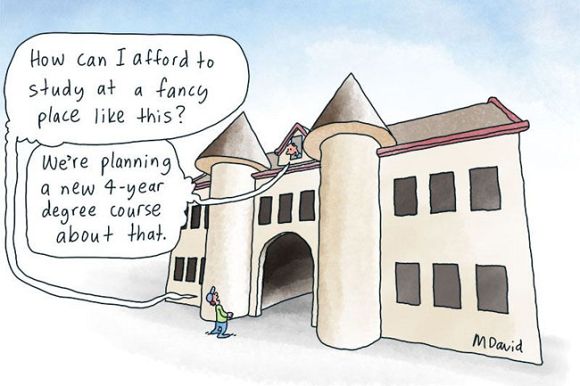Financial strain faced by the ANU highlights a need for a strategy that puts students, research and innovation at the heart of our national agenda, writes Vince Hooper.
THE AUSTRALIAN NATIONAL UNIVERSITY (ANU), one of the country’s premier institutions, is forecasting a deficit exceeding $200 million. While alarming in its own right, this shortfall is not an isolated event — it signals systemic fragility across Australia’s higher education sector.
As government funding plateaus, international enrolments fluctuate and costs rise, ANU’s financial pain offers a warning to the entire university system.
Financial strain and restructuring
In response to its fiscal crisis, ANU is rolling out a $250 million cost-cutting plan over the next 15 months. Administrative streamlining, academic restructuring and staff reductions are already underway. These measures mirror those at other universities across the country, where campuses are grappling with falling revenues and uncertain futures.
At the heart of this problem are two structural weaknesses: declining real government investment and overdependence on international student fees. The introduction of the Job-ready Graduates Package further shifted the financial burden onto students. This marketised model now leaves institutions vulnerable to geopolitical instability, exchange rate shocks and post-pandemic global enrolment trends.
The broader impact on equity and access
Universities have long been engines of social mobility. However, aggressive cost-cutting risks turning them into exclusive enclaves. As tuition fees rise and programs shrink, access to higher education could narrow, particularly for students from rural, Indigenous, or low-income backgrounds.
At the very moment Australia needs a more inclusive education model to meet skills shortages and support regional development, the sector may be retreating behind economic barriers. Universities must balance fiscal responsibility with their civic mission to remain truly public institutions.
A threat to student experience and well-being
The student experience is already deteriorating. Larger class sizes, fewer course options and reductions in counselling, careers support and mental health services are affecting engagement and well-being. With finances under pressure, student-centric policies often take a backseat to institutional survival.
The long-term reputational costs of this erosion could be severe, making Australian universities less attractive to both domestic and international cohorts.
Research and global partnerships in jeopardy
One of the greatest concerns stemming from the ANU deficit is its knock-on effect on research. Australia's universities, including ANU, have historically secured international grants, built strategic partnerships and attracted top-tier global talent. But these relationships are increasingly at risk.
Recent geopolitical tensions and the deterioration of research collaborations with key partners, particularly in the U.S. and Europe, are already being felt. Combined with shrinking domestic support, the pressure to fund research through teaching income becomes unsustainable. Without new solutions, Australia's capacity for innovation may be stifled and our global research standing diminished.
Universities Accord: A step forward, but time is of the essence
The Federal Government’s Universities Accord Final Report (2024) sets out a long-term vision to address structural issues in the sector. Its emphasis on equity-based funding, research capacity and long-term sustainability is welcome. However, implementation timelines remain vague and universities need immediate relief.
Policy reform cannot remain stuck in the consultative phase. A coordinated approach that includes public reinvestment, fee regulation and targeted support for regional and research-intensive institutions is vital to avoid further decline.
The risks of digital disruption — and the opportunity
Amid crisis lies opportunity. Universities must now reimagine their financial models, not only by cutting costs, but also by innovating. This means embracing digital transformation, micro-credentials, hybrid delivery models and partnerships with industry.
Australia’s universities are well-placed to lead in education technology, especially in delivering lifelong learning and workforce retraining. These initiatives offer both a new revenue stream and a way to meet emerging labour market needs. However, capitalising on this will require upfront investment, agility and a cultural shift away from traditional models of delivery.
Governance and accountability
Public trust in universities is also shaped by perceptions of transparency and governance. Executive salaries, capital expenditure and opaque decision-making processes have raised questions, especially in times of austerity. Institutions must demonstrate they are stewarding their resources responsibly.
Clearer accountability mechanisms, inclusive governance and greater staff and student representation in decision-making would strengthen confidence in the sector’s long-term direction.
Philanthropy, endowments, and the power of alumni
Unlike elite institutions in the United States or the United Kingdom, Australian universities have not traditionally leaned heavily on philanthropic giving. However, in the face of funding constraints, now is the time to grow endowment funds, engage alumni networks and develop a stronger culture of giving.
Some universities are already experimenting with matched-donation programs, legacy giving and corporate partnerships. These efforts need to be scaled and professionalised if they are to provide a meaningful buffer against volatile student income. Philanthropy won’t replace core funding, but it can help stabilise institutions and support scholarships, infrastructure and research.
National competitiveness and the future workforce
The health of Australia’s university sector is not a niche concern — it is central to national prosperity. Universities train the professionals who build our economy, staff our hospitals and shape our democracy. They drive innovation, contribute to regional development and foster international diplomacy.
Allowing them to drift into long-term decline undermines Australia’s competitiveness on the global stage. Investment in higher education is not a cost, it is an investment in our workforce, our intellectual capital and our social cohesion.
Conclusion: A time for bold action
The ANU deficit is more than a line on a balance sheet — it is a canary in the coal mine. It signals that the current model of Australian higher education is no longer fit for purpose. A pivot is urgently needed: away from narrow cost-cutting and toward diversified, resilient and future-ready institutions.
Universities must evolve. So, too, must government policy, funding mechanisms and institutional governance. If we fail to act decisively now, we risk hollowing out one of our most valuable national assets.
The future of Australian higher education depends on courageous choices. The time for incremental reform is over. What we need is a bold, strategic and inclusive vision that puts students, research and innovation at the heart of our national agenda.
Vince Hooper is a proud Australian/British citizen who is professor of finance and discipline head at SP Jain School of Global Management with campuses in London, Dubai, Mumbai, Singapore and Sydney.
 This work is licensed under a Creative Commons Attribution-NonCommercial-NoDerivs 3.0 Australia License
This work is licensed under a Creative Commons Attribution-NonCommercial-NoDerivs 3.0 Australia License
Support independent journalism Subscribe to IA.

Related Articles
- Australian universities being hijacked by corporate elites
- Unchecked vigilante violence on campus smacks of ambient fascism
- Money-mad universities fail to stop violence against protesters
- Universities Accord fails to restore integrity to higher education
- Universities Accord seeks to reform education and immigration policy














